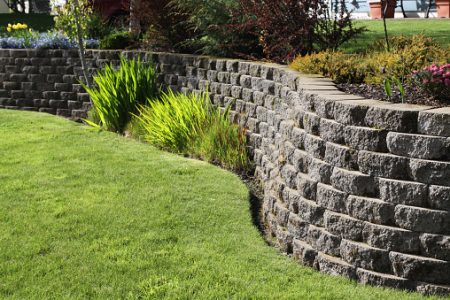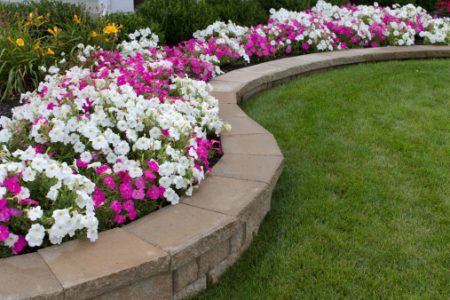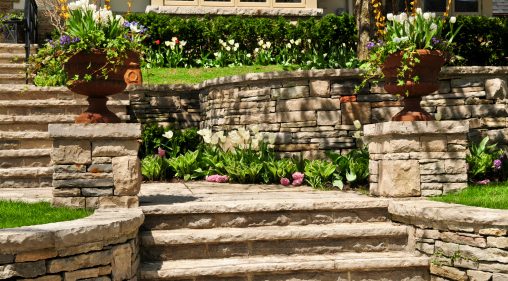Sloped gardens are certainly not ideal for most gardeners. They affect the drainage of the soil, add to problems with erosion, and can make planting crops an extremely difficult task. Even mowing the lawn becomes a much more tiresome task as you have to spend at least half of it walking uphill. This is not something any gardener really wants, whether they are young or getting on in a few years.
One of the most common solutions to a sloped garden is to transform it by building terraces on it .
By building a tiered garden on a slope, you are giving yourself far more options when it comes to what you can do with your outdoor space. You will have a far greater number of plants to choose from once your terraces are built, you can turn that sloped lawn into a few, smaller and flatter grassy areas that are much less hassle to cut, and you will give your garden an incredible new look in the process.
Sound good? Well strap on your wellies as we show you how to build a tiered garden on a slope.
Building a tiered garden on a slope: Planning
As with all DIY jobs, the better you plan, the better the results. The main thing you need to know, before anything else can be planned, is the rise and run of your garden slope. The run is the horizontal distance from the top of the slope to the bottom of it. The rise, as you might have guessed, is how tall the top of the slope rises from the bottom of it.
One of the easiest ways to work these measurements out is to use a couple of poles, a length of string, and a spirit level. Stick one pole in the ground at the top of the slope and one at the bottom. Tie the string to the base of the pole at the top of the hill, and then tie the other end to the other pole.
Use your spirit level to check that the string runs perfectly horizontal between the two. Once you are happy that it’s right, simply measure out the distance the string covers for the run, and measure from the ground up to the string on the lower pole for the rise.
Armed with your measurements, you can now plan how big your flat tiers will be on a piece of paper. It will also tell you how tall your retaining wall is going to have to be.
Building a tiered garden on a slope: retaining wall
To build a tiered garden on a slope, you are going to need to know how to build a proper retaining wall. We have an in depth, step by step, article on how to build a retaining wall for your garden that will guide you through the entire process, so I won’t go into huge details here. Just follow the link and it will teach you everything you need to know, including the depth to dig, the best materials, and how to create proper drainage, which is absolutely essential.

You can build retaining walls out of rocks, large pieces of timber, logs, bricks, or concrete blocks. You can also use cages filled with rocks that are called gabions. The choice is largely a personal one and should be something that suits your vision for your future tiered garden, but also something you know you can rely on to withstand the forces placed upon it. A petrol auger with supports isn’t a bad shout either.
Please don’t undertake building a tiered garden on your garden slope if you aren’t prepared to put in a lot of work. Doing this is quite a labour intensive task, with a lot of digging and lugging heavy materials around, so if you are not that physically able, it might be better paying someone else to do it for you.
Building a tiered garden on a slope: piling in the soil
Once you’ve built your retaining wall, you are now ready to put your soil down behind it. If you’re not sure how much soil to pile in there you can use your rise and run measurement to help you work out the area of a triangle. Then you just multiply this by your retaining wall length and it will give you a fair enough idea of how much soil to pack in.
Once the soil is in, it is incredibly important that you take your time checking that it is level. So, grab your spirit level and get to work. If your soil isn’t level, add more topsoil, or take some away until you’re happy. Try to use the soil from your garden as much as possible rather than buying topsoil, or disposing of large quantities of your original soil. It’ll save you money in more ways than one. If you’re worried about soil quality check the link provided.
When everything is level, it is a good idea to use a soil compactor to get rid of any underlying air pockets, or unseen cavities. Doing this has multiple benefits, but the main one is stopping your nice, flat, garden from becoming anything but that due to rainfall.
Building a tiered garden on a slope: Planting

All that’s left to do now, is to decide on what you are going to plant on your new tiered terraces. Will you just plant grass seed down and have multiple levels of beautiful, emerald green grass? Or perhaps, you will plant beds filled with a wide variety of plants on each tier, filling your garden with colour? Maybe you want to use those beds for growing vegetables? You will want to think about the shape of your borders as well.
How to pick the best lawn mower for slopes (UK)
Whatever you decide to go with, we are sure it will look so much better than a boring old slope, and certainly make you feel much happier when you look out of the window.
For now, that’s all from us here at garden toolbox, but why don’t you spend a few moments browsing this site that we are so proud of. We put a lot of work into bringing you the most comprehensive gardening information, how to articles, tips and tricks, growing guides, and product reviews.
